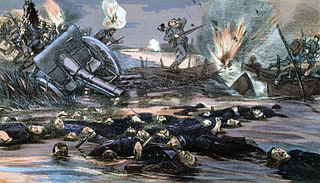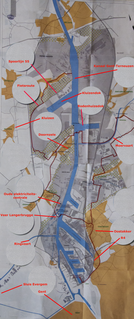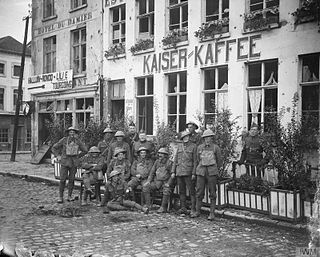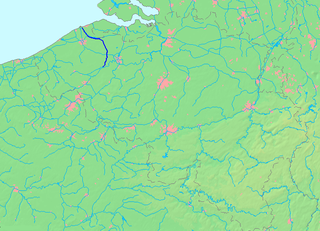
Transport in Belgium is facilitated with well-developed road, air, rail and water networks. The rail network has 2,950 km (1,830 mi) of electrified tracks. There are 118,414 km (73,579 mi) of roads, among which there are 1,747 km (1,086 mi) of motorways, 13,892 km (8,632 mi) of main roads and 102,775 km (63,861 mi) of other paved roads. There is also a well-developed urban rail network in Brussels, Antwerp, Ghent and Charleroi. The ports of Antwerp and Bruges-Zeebrugge are two of the biggest seaports in Europe. Brussels Airport is Belgium's biggest airport.

Ghent is a city and a municipality in the Flemish Region of Belgium. It is the capital and largest city of the East Flanders province, and the third largest in the country, exceeded in size only by Brussels and Antwerp. It is a port and university city.

The Scheldt is a 350-kilometre-long (220 mi) river that flows through northern France, western Belgium, and the southwestern part of the Netherlands, with its mouth at the North Sea. Its name is derived from an adjective corresponding to Old English sceald ("shallow"), Modern English shoal, Low German schol, West Frisian skol, and Swedish (obsolete) skäll ("thin").

West Flanders is the westernmost province of the Flemish Region, in Belgium. It is the only coastal Belgian province, facing the North Sea to the northwest. It has land borders with the Dutch province of Zeeland to the northeast, the Flemish province of East Flanders to the east, the Walloon province of Hainaut in the southeast and the French department of Nord to the west. Its capital is Bruges (Brugge). Other important cities are Kortrijk in the south and Ostend (Oostende) on the coast, Roeselare and Ypres (Ieper). The province has an area of 3,197 km2 (1,234 sq mi) which is divided into eight administrative districts (arrondissementen) containing 64 municipalities. As of January 2019, West Flanders has a population of 1,195,796.

The siege of Antwerp was an engagement between the German and the Belgian, British and French armies around the fortified city of Antwerp during World War I. German troops besieged a garrison of Belgian fortress troops, the Belgian field army and the British Royal Naval Division in the Antwerp area, after the German invasion of Belgium in August 1914. The city, which was ringed by forts known as the National Redoubt, was besieged to the south and east by German forces.

The Battle of the Yser was a battle of the First World War that took place in October 1914 between the towns of Nieuwpoort and Diksmuide, along a 35 km (22 mi) stretch of the Yser River and the Yperlee Canal, in Belgium. The front line was held by a large Belgian force, which halted the German advance in a costly defensive battle.

The Flemish peasant revolt of 1323–1328, sometimes referred to as the Flemish coast uprising in historical writing, was a popular revolt in late medieval Europe. Beginning as a series of scattered rural riots in late 1323, peasant insurrection escalated into a full-scale rebellion that dominated public affairs in Flanders for nearly five years until 1328. The uprising in Flanders was caused by both excessive taxations levied by the Count of Flanders Louis I, and by his pro-French policies. The insurrection had urban leaders and rural factions which took over most of Flanders by 1325.

The Port of Ghent is the third busiest seaport in Belgium, located in Ghent, East Flanders in the Flemish Region. The first port of Ghent was situated at the river Scheldt and later on at the Leie. Since the Middle Ages Ghent has sought for a connection to the sea. In the 13th century via the Lieve canal to the Zwin near Damme, in the 16th century via the Sassevaart, in the 17th century via the Ghent–Bruges canal. Since the 19th century, the Ghent–Terneuzen Canal connects the port via the Western Scheldt to the North Sea. The port of Ghent is accessible by ships of the Panamax size, and in February 2015 the construction of a new lock at Terneuzen was announced, which will maintain near-parity with those of the Panama Canal expansion project.
The Council of Flanders, primarily sitting in the Gravensteen in Ghent from 1407, was a court of law operating under the authority of the Count of Flanders and exercising jurisdiction throughout the County of Flanders.

The Roeselare–Leie Canal is an artificial waterway between the town Roeselare and the river Leie in West Flanders, Belgium. The canal is 16.5 kilometres long and was dug in 10 years between 1862 and 1872. The employment grew and ships with a carrying capacity of 600 tonnes brought grain, sand and other basic products to the factories around the canal.

Kortrijk, sometimes known in English as Courtrai or Courtray, is a Belgian city and municipality in the Flemish province of West Flanders.

The Nieuwpoort–Dunkirk Canal is a canal which links the Belgian coastal town of Nieuwpoort with the French port Dunkirk. The Nieuwpoort–Dunkirk Canal forms an extension of the Plassendale–Nieuwpoort Canal, and runs for 32 kilometres (20 mi) pretty much parallel to the coast line, within two to four kilometers from the sea.

The Battle of the Lys and the Escaut was the third and last phase of the Second Battle of Belgium or the Ypres-Lys Offensive, and took place in Belgium between 20 October and 11 November 1918.

The Schipdonk Canal is a canal in the Belgian provinces of East Flanders and West Flanders. With a length of 56 km (35 mi), the canal runs in a northerly direction from Deinze, turning to a north-western direction roughly halfway along its route to the North Sea with which it meets on the coast near to Heist. It crosses both the Ghent-Bruges Canal and for its final 20 km (12 mi) runs parallel with the Leopold Canal as it approaches the north Belgian coast. For most of this final section the two canals are separated only by a dyke.

The Liberation of Belgium from German occupation was completed on 4 February 1945 when the entire country was reportedly free of German troops with the liberation of the village of Krewinkel. The operation began when Allied forces entered on 2 September 1944. The liberation came after four years of German-occupied rule. The Belgian government was returned to power on 8 September 1944, after Allied forces captured Brussels four days earlier.

Martin Bauwens of Riethoven or Martinus Rythovius was a Catholic theologian and the first Bishop of Ypres. He was a figure of some spiritual and political significance during the early decades of the Dutch Revolt.

Franciscus Renatus Boussen or Frans Boussen(1774–1848) was the 18th bishop of Bruges, and the first after the re-establishment of the diocese in 1834.
The 1st Infantry Division is a Infantry Division of the Belgian Army that fought in the Battle of Belgium against the German Armed Forces.

The Revolt of Ghent (1379-1385) was an uprising by the city of Ghent against the count of Flanders and the king of France. Under the leadership of successively Jan Hyoens, Philip van Artevelde and Frans Ackerman, Ghent rebelled against Count Louis II of Flanders, Duke Philip the Bold of Burgundy and King Charles VI of France. It was an expression of the growing power of the Third Estate and of economic ties with England that had been strained by the Hundred Years' War. After six years of war, Ghent submitted to the ducal authority while avoiding further punishment. The dream of an autonomous city-state has failed and the era of royal centralization continued.















